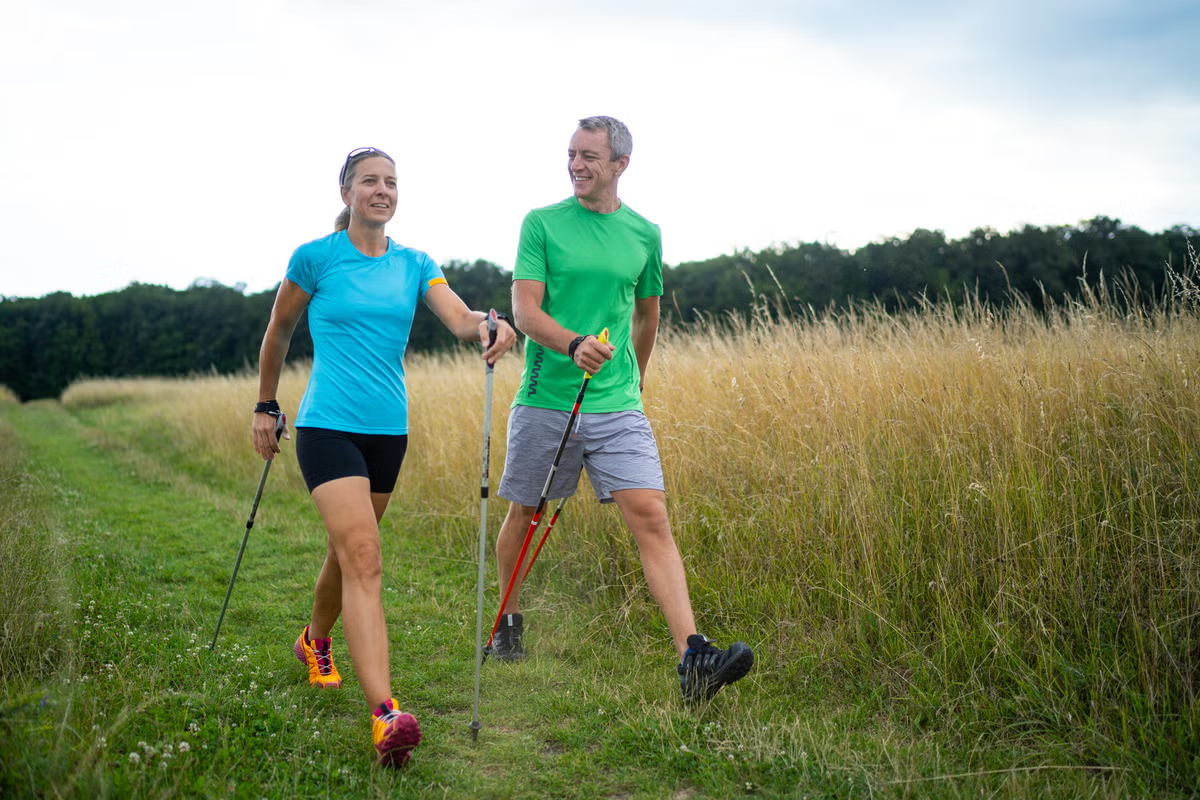New research reveals the exercise six times more effective than walking for fighting heart disease

“Nearly 1.8 billion adults are at risk of disease from not doing enough physical activity,” a 2024 World Health Organisation statement reads. At the time of writing, this figure was on the rise.
A lack of physical activity puts adults at greater risk of cardiovascular diseases such as heart attacks and strokes, type 2 diabetes, dementia and cancers such as breast and colon, the organisation writes. But new research from the University of Sydney suggests a certain type of exercise could be more powerful in preventing these conditions than previously thought: vigorous-intensity activity.
The new data found vigorous-intensity activity to be six times more effective at lowering your risk of cardiovascular disease than moderate-intensity activities like brisk walking, lead author Professor Emmanuel Stamatakis tells me. In other words, for every one minute of vigorous-intensity activity you do, you would need to do six minutes of a moderate-intensity activity to have the same impact on heart health.
“For diabetes, it’s nine times more effective, and for all-cause mortality and cancer it’s a little bit lower,” Professor Stamatakis adds.
The term “vigorous-intensity activity” is relative – depending on factors such as your age and fitness level, it could mean anything from a swim or cycle to a high-intensity interval training (HIIT) workout. The telltale signs are; your heart is beating fast; you are breathing hard to the point you can’t speak in full sentences; you can’t maintain this intensity for more than a few minutes at a time.
If you can reach this intensity a few times per week, you can reduce your risk of chronic illness, the University of Sydney’s study suggests.
Vigorous-intensity physical activity
‘The signs of vigorous intensity will be very clear. For a non-athlete aged 30 and up who doesn’t do much exercise, they shouldn’t be able to maintain this intensity for more than two to three minutes without a break. It will be a significant effort, you will be getting out of breath and your heart will be pounding. You should be able to talk, but only say a few words at a time.’
Moderate-intensity physical activity
‘You will feel slightly out of breath – you can talk and hold a discussion, but you can’t sing comfortably because your respiratory system is quite engaged. There is a certain level of exertion, but you can sustain this for many minutes or even hours.’
Light physical activity
‘Light physical activity is any very low-intensity activity where you are moving but your heart rate is barely raised, such as a slow walk.’
What the science says
The World Health Organisation recommends adults do at least 150 minutes of moderate-intensity physical activity like brisk walking, 75 minutes of vigorous-intensity physical activity like faster running or HIIT, or an equivalent of both. These physical activity guidelines have been widely adopted by the likes of the NHS.
But this new research, published in the Nature journal, challenges the implicit 2:1 benefit ratio of the two intensities, suggesting you might need less vigorous-intensity activity or more moderate-intensity activity than previously thought to achieve the same health outcomes.
“We make a lot of fuss about the intensity of physical activity in our research because, firstly, different intensities have different health effects, and secondly, the higher the intensity, the higher the health value usually is,” says Professor Stamatakis.
His latest study used wearable data from 73,485 UK participants to assess the health impacts of light, moderate and vigorous activity against a selection of specific health outcomes; cardiovascular mortality, major adverse cardiovascular events, type 2 diabetes and cancer.
Health outcome
Amount of vigorous-intensity activity
Median equivalence in minutes to see the same response from moderate-intensity activity
Median equivalence in minutes to see the same response from light activity
Type 2 diabetes incidence
1 minute
9.4 minutes
94 minutes
Cardiovascular mortality
1 minute
7.8 minutes
72.5 minutes
Major adverse cardiovascular events
1 minute
5.4 minutes
86.1 minutes
All-cause mortality
1 minute
4.1 minutes
52.7 minutes
Physical activity related cancer mortality
1 minute
3.5 minutes
156.2 minutes
Physical activity related cancer incidence
1 minute
1.6 minutes
5.1 minutes
The obvious conclusion here is that a time-efficient exercise routine should hinge on vigorous-intensity activity. If you prefer moderate-intensity activities like brisk walking, you can use these to obtain similar health benefits, but the time commitment required for the same gains will be considerably greater.
On the other hand, no amount of light activity, like a slow walk, can replicate “some of the core physiological responses from vigorous-intensity activity”.
“When it comes to light activity, some movement is better than none,” Professor Stamatakis explains. “Moving around instead of sitting down is good for metabolic disease and energy expenditure.
“But when it comes to functional capacity, and cardiorespiratory fitness in particular, you need intensity to challenge your physiology. Vigorous-intensity activity will force the heart to strengthen its muscle, improving its capacity to pump blood. Very few of these things happen with light intensity activity, even in large amounts.”
Read more: The thing most people get wrong when exercising – and why it’s costing them results
open image in gallery
Walking or running uphill, or up stairs, can be a way to increase the intensity of an activity (Getty/iStock)
How to exercise for maximum health benefits, based on this research
“Compared to people who don’t do any vigorous-intensity activity as part of their day-to-day routines, introducing anything – even four to five minutes per day – seems to have some effect long term,” says Professor Stamatakis.
This relates to another paper he co-authored earlier this year. The research found that five to 10 short daily bursts of vigorous intermittent lifestyle physical activity (or VILPA), such as climbing the stairs or carrying heavy shopping, can significantly lower the risk of cardiovascular disease, cancer and premature death in less active populations. These bouts of VILPA can be accrued through 60-second bursts of physically challenging activities during the day.
The key to achieving lifelong benefits is to make these active behaviours into a habit, Professor Stamatakis asserts.
“We’re not talking about doing it once a week or whenever you remember, we’re talking about a daily behaviour,” he says.
Those currently living a sedentary lifestyle are the most likely to see significant benefits from introducing short bouts of vigorous-intensity activities into each day.
“If someone does no vigorous-intensity activity, very little moderate-intensity activity – let’s say 15 minutes or less – and a few hours of light activity per day, that’s a very sedentary individual,” Professor Stamatakis says.
“Typically, they will do under 5,000 or 6,000 steps per day. A very sedentary non-bedridden person – someone who does no planned physical activity, just essential movements like going to the car to drive to work, going to the supermarket for food or going to the bathroom – will accumulate about 4,000 steps.
“For such an individual, if they aim to incorporate seven short bursts of vigorous activity per day, or if you go by this study the equivalent is 63 minutes of moderate activity, they will lower their risk of health outcomes like cardiovascular diseases.”
Read more: From back pain to heart health – Experts reveal how to counter the negative effects of too much sitting down
open image in gallery
The most important factor in securing long-term health benefits is finding a type of exercise you can stick with (Getty/iStock)
Dealer’s choice, and why vigorous-intensity activity is not for everyone
The aim of this study is not to impose vigorous-intensity activity across all populations. Rather, it aims to provide people with more strings to their bow when creating an effective and sustainable exercise routine for fending off chronic illnesses.
If you are short on time, vigorous-intensity physical activity can help you maximise exercise efficiency, particularly if you use short bursts of challenging lifestyle activities like climbing the stairs and carrying heavy shopping. These acts can also familiarise you with the feeling of a workout, paving the way for more formal exercise later down the line.
However, this approach won’t work for everyone. Pushing people into a type of exercise they don’t enjoy can leave a “bad taste in their mouth”, souring their relationship with movement.
“The higher the intensity, the more discomfort comes with it,” says Professor Stamatakis. “We know this discomfort is a reason why some people quit exercise – because they don’t enjoy it. This is especially true in the population we’re interested in, which is physically inactive people.”
If this is the case, moderate-intensity activity is a good alternative. You will have to devote more time to it – even more than previously thought, this latest study suggests – but it could be a more sustainable and enjoyable approach for certain people.
“If someone cannot do vigorous activity, or they can’t integrate it into their day-to-day routine for whatever reason, what is the point of prescribing and advocating vigorous intensity?” Professor Stamatakis asks.
“It could be that a very sedentary 60- or 70-year-old gentleman may enjoy going to the park with their grandchildren or going for a slow walk with a friend and chatting – that’s absolutely fine.
“You have to be considerate and respectful towards people’s preferences; you have to acknowledge their circumstances and, considering everything, support them in the best possible way to integrate activity into their days.
“The point here is to give people as many options as possible, hoping that one of them will be the option they can stick with. It’s all about establishing habits – not doing things once a week or once a month.”
Read more: Experts say including more of this in your diet can help you live a longer, healthier life – and it’s not protein or fibre





